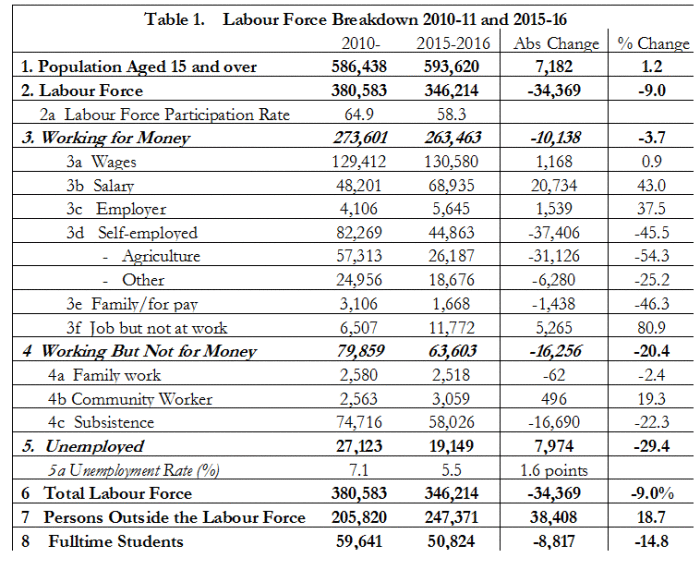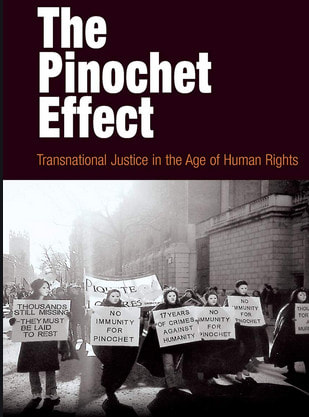The Fiji Bureau of Statistics has released the Preliminary Findings from their 2015-16 Employment and Unemployment Survey (EUS) (FBoS Release No: 34, 2017 (7 August 2017) from which I present their Table 1 (with line numbers added by me to help the reader).
A Media Release from the Ministry of Information, then reported the Minister for Economy (Mr. Aiyaz Khaiyum) using this FBS Preliminary findings to draw a number of glowing conclusions not justified by the statistics at all, except for No. 1, 5 and 6 below, with my comments in brackets.
- Fiji’s unemployment rate has declined from 7.1 per cent in 2010-2011 to 5.5 per cent in 2015-2016, the lowest unemployment rate on record over the last 15 years (Line 5a). (CAREFUL!)
- This was clear evidence that the record growth achieved by the Fijian economy was inclusive, and that ordinary Fijians were feeling the full benefits of Fiji’s economic development. (NOT SUPPORTED)
- The strong economic management and consistent policies … targeted investment in infrastructure and service delivery, have already brought us eight straight years of economic growth … translated directly into more jobs and new investment opportunities for the Fijian people. (NOT SUPPORTED)
- The number of employers in Fiji in 2015-2016 increased by 37 per cent from 2010-2011 (Line 7)…. a major victory for Government’s pro-growth policies that have supported private sector activity in the Fijian economy. (CAREFUL!)
- The statistics on school participation showed that while 3,500 persons aged 6 to 17 had dropped out of school in 2010-11, only 3,182 persons had dropped out in 2015-16. (CORRECT)
- The percentage of dropouts that had left the education system due to financial constraints had also dramatically dropped from 31.9 per cent in 2010-2011 to 4.8 per cent in 2015-2016. (CORRECT)
- The Minister for Labour (Mr. Jone Usamate) then also commented that “the findings depicted that Government policies were effective… it shows that these policies are beginning to work because unemployment is reducing”. (NOT SUPPORTED)
Unfortunately, nearly all these Bainimarama Government claims (except that on education) look very shaky when one examines the detailed FBS preliminary findings more closely as in Table 1.
Beware the definitions
I remind the readers that the statistics provided by the FBS Press Release are based on very strict ILO advised definitions, which can trap the unwary.
First, all the employment numbers given in the tables in the FBS Press Release relate only to those aged 15 years and over, not to those 14 and under children in Fiji who may be working.
The “Labour Force” is defined by the ILO as “those who are working or are available for work”.
The “Unemployed” are those who say they are “available for work, and actively looking for work”.
Let me start with the “good news” which I think are quite credible.
Good news on education
Claims 5 and 6 on the progress in education are probably sound and as I would have expected. The Bainimarama Government’s freeing up of secondary and tertiary education “for those who qualify” must have reduced dropouts from school.
The result that students who have dropped out for financial reasons has declined from 32% to 5% (another table) is quite credible.
Doubtful Claims 2 and 3: Few Jobs Created
Unfortunately, the FBS Preliminary release does not support the claims by Minister Khaiyum and Minister Usamate that the massive infrastructure investments and high economic growth of the last five years has created a great number of jobs. Indeed the statistics in Table 1 suggest the opposite.
Line 3 in Table 1 shows that those “Working for Money” has declined between 2010-11 and 2015-16 by a large 10,138 or 3.7%.
The massive two billion of infrastructure spending and high rates of economic growth have not translated into cash economy jobs.
Indeed, those working for wages (Line 3a) has increased by a mere 1,168 over the five years (or just 233 jobs per year) or less than 1 percent over a five year period. This is a shockingly small increase in jobs given the rates of increase of GDP.
Those working for salary has increased by 20,734 and a large 43% (Line 3b) but I suspect these were probably largely in the public sector or in one of the few private economy growth areas such as tourism.
In any case, these job increases are the middle income or upper income jobs, not at the low income level were wage jobs usually are. Remember that there are twice as many wage earners in Fiji than salary earners (compare Lines 3a and 3b).
So Khaiyum’s claim that their economic growth was “inclusive” and for “ordinary Fijians” is not supported by the data.
Equally worrying is that those who are “Working But Not For Money” (Line 4) or Family work, Community Worker and Subsistence declined by a massive 16,256 or massive 20%. Subsistence workers declined by 16,690 while Community Workers increased by a mere 496 (Line 16).
Overall, the data indicates that the Labour Force (Line 2 and 6) declined by a huge 34,000 or 9%. This is an extraordinary result given that the 15 and over age group has increased over the period (slightly by 1%).
Claim 4 Number of Employers
Khaiyum correctly quotes the FBS result that the number of “employers” increased by 37.5% (Line 3c).
However, his claim that this was “a major victory for Government’s pro-growth policies that have supported private sector activity in the Fijian economy” is on very shaky grounds indeed. The “employers” category in the survey covers a mere 1% of those employed and the 37.5% percentage increase over 5 years amounts to a total of 1,539 only (Line 3c) and most are the very small employers in the informal sector.
It would not surprise me if this number also includes some who have started their own small businesses after being retired by the Bainimarama Government at the age of 55.
The overall reality is that this increase in numbers of small employers, did not bring about any great increase in jobs in the economy while those who are classified as “Self-employed” (Line 3d) fell by a massive 37, 406, both in Agriculture (-31,126) and Other areas (-6,280).
These numbers all taken together suggest that far from the private sector being dynamic and growing, it has been contracting between 2010-11 and 2015-16.
Claim 1: The Unemployment Rate
Yes, the “Unemployed” as technically defined by ILO may have declined from 7.1% to 5.5%, a decline of 7,974 persons. But I remind you about how the “Unemployed” is defined by FBS and ILO: those who are not working and “Looking for Work”.
But what about all those simply stopped looking for work because there is no work available? That will explain far better the hundreds of unemployed persons (mostly youth) who are hanging around all the major city centers and highly visible.
While the narrowly defined “Unemployment Rate” shows that it is declining, the harsh reality is that it is not through any great increase in the number of jobs.
The reality also is that a large number of so-called “Employed” persons (especially those “Working But Not For Money”) are significantly “underemployed”, working only part of the day, week, month or year.
From the 2010-11 EUS data which I have analyzed, the extent of this underemployment was more than 30% of the Labor Force, NOT the 7% or 5% officially “Unemployed”.
It is a terrible pity that Fiji’s political leaders are focusing only on the little bits of data that suits their propaganda purpose, coming out of the Fiji Bureau of Statistics, while ignoring the real substantive results.
Thankfully, such cherry-picking of FBS statistics to suit political purposes, is all too easily caught out.
Postscript 1 A rich data source underutilized
These Employment and Unemployment surveys are treasure troves of information on not just employment and unemployment, but also underemployment, gender inequalities in incomes, hours of work done in paid and unpaid household work, on time spent on leisure activities like religious activities, sports, kava drinking, television and video, and even reading.
My Report on the 2010-11 Employment and Unemployment Survey (Fiji Women and Men at Work and Leisure), financed by AusAID, was ready for publication in 2013. That Report was full of policy recommendations which would have been of great use not just to the Minister for Labour and Employment creation, but also the Minister for Women, Youth and Health and civil societies.
That valuable report was not published because the Minister for Economy refused to give permission, probably because it had some negative results on employment creation between 2005 and 2011.
It is tragic for Fiji that politicians have prevented the public from accessing the reports that their taxpayer (and donor) funds have paid for, another “First in the history of Fiji” for the Bainimarama Government.
Four years later, it is still not published while the Preliminary Findings from the 2015-16 EUS is now slowly dribbling out from the FBS.
Do these Ministers have the courage to demand that the FBS to make available to them that 2013 Report and indeed have it published so that civil society can make use of this valuable source of information, paid for by taxpayers?
Postscript 2 Another example of localization reversed
The only Fijian expert on analyzing such household surveys has been banned from analyzing that survey data, writing the reports and organizing the national workshops at which Government and NGO stakeholders could discuss the valuable findings.
Because of the Bainimarama Government wish to control the official statistics, the FBS has now gone back to being dependent on foreign experts, usually from WB and ILO, who come and go, without any accountability to the people of Fiji.
Who knows when the Final Reports from the 2015-16 EUS will come out?
Postscript 3 Where is the Final Report from the 2013-14 HIES
I remind the public that there is still no Final Report from the 2013-14 HIES which was being analyzed by the World Bank, apart from some initial poverty results.
No policy recommendations have been brought out on poverty, income distribution, or food security, or the myriad other fascinating aspects which HIES data can reveal.
See my Report on the 2008-09 HIES) and the many workshops I ran in conjunction with Dr Mahendra Reddy (then at FNU). To date, there have been no workshops run on the results from the 2013-14 HIES results.
Who knows what is in those statistics that this Bainimarama Government does not want the public to see?
It seems that nobody in the Bainimarama Government or the public cares at all.


